
Cyperus papyrus, better known by the common names papyrus, papyrus sedge, paper reed, Indian matting plant, or Nile grass, is a species of aquatic flowering plant belonging to the sedge family Cyperaceae. It is a tender herbaceous perennial, native to Africa, and forms tall stands of reed-like swamp vegetation in shallow water.

The Cyperaceae are a family of graminoid (grass-like), monocotyledonous flowering plants known as sedges. The family is large, with some 5,500 known species described in about 90 genera, the largest being the "true sedges" genus Carex with over 2,000 species.

Cyperus is a large genus of about 700 species of sedges, distributed throughout all continents in both tropical and temperate regions.
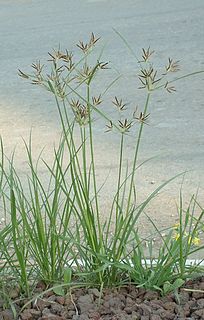
Cyperus rotundus is a species of sedge (Cyperaceae) native to Africa, southern and central Europe, and southern Asia. The word cyperus derives from the Greek κύπερος, kyperos, and rotundus is from Latin, meaning "round". The earliest attested form of the word cyperus is the Mycenaean Greek 𐀓𐀞𐀫, ku-pa-ro, written in Linear B syllabic script.
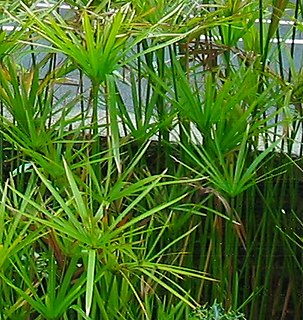
Cyperus alternifolius, the umbrella papyrus, umbrella sedge or umbrella palm, is a grass-like plant in the very large genus Cyperus of the sedge family Cyperaceae. The plant is native to West Africa, Madagascar and the Arabian Peninsula, but widely distributed throughout the world. It has gained the Royal Horticultural Society's Award of Garden Merit. The subspecies Cyperus alternifolius ssp. flabelliformis is also known as Cyperus involucratusRottb..

Gerrothorax is an extinct genus of temnospondyl amphibian from the Triassic period of Greenland, Germany, Sweden, and possibly Thailand. It is known from a single species, G. pulcherrimus, although several other species such as G. pustuloglomeratus have been named in the past.
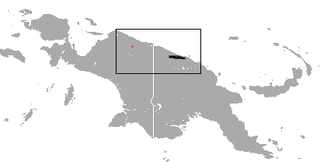
The golden-mantled tree-kangaroo is a species of tree-kangaroo endemic to the Northern New Guinea montane rain forests ecoregion of the island.
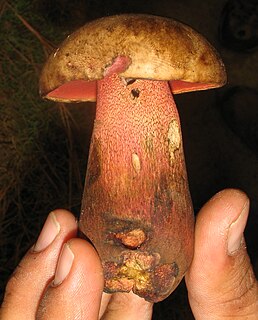
Rubroboletus pulcherrimus—known as Boletus pulcherrimus until 2015—is a species of mushroom in the family Boletaceae. It is a large bolete from Western North America with distinguishing features that include a netted surface on the stem, a red to brown cap and stem color, and red pores that stain blue upon injury. Until 2005 this was the only bolete that has been implicated in the death of someone consuming it; a couple developed gastrointestinal symptoms in 1994 after eating this fungus with the husband succumbing. Autopsy revealed infarction of the midgut.

Climacodon pulcherrimus is a species of tooth fungus in the family Phanerochaetaceae. It was first described as a species of Hydnum by Miles Berkeley and Moses Ashley Curtis in 1849. T.L. Nikolajeva transferred it to its current genus Climacodon in 1962, but research published in 2007 suggests it should be placed in a different genus. It is widely distributed in subtropical and tropical areas, where it grows on decomposing hardwoods, causing a white rot.
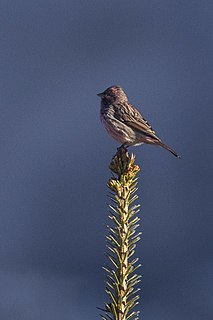
The Himalayan beautiful rosefinch is a true finch species. It is found in mid-western China and the northern Himalayas. Its natural habitats are temperate shrubland and subtropical or tropical high-altitude shrubland.

The golden-collared honeycreeper is an uncommon species of Neotropical bird in the tanager family Thraupidae. It is the only member of the genus Iridophanes.

The golden-naped barbet is a member of the family Megalaimidae. It is found in Indonesia and Malaysia, where it is endemic to the island of Borneo. Its natural habitats are subtropical or tropical moist lowland forest and subtropical or tropical moist montane forest.

Cyperus eragrostis is a species of sedge known by several common names, including tall flatsedge, nutgrass, tall nutgrass, umbrella sedge, chufa, Earth almond, zula nuts, edible galingale and pale galingale.

Cyperus fuscus is a species of sedge known by the common name brown galingale, or brown flatsedge. This plant is native to much of Europe, Asia and North Africa from England, Portugal and Morocco east to China and Thailand. It is an introduced species in North America, where it is naturalized in widely scattered locations in the United States and Canada.

Cyperus scariosus is a perennial herbaceous plant from Australia and New Guinea.
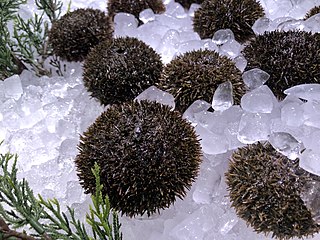
Hemicentrotus pulcherrimus is a species of sea urchin, the only one in the monotypic genus Hemicentrotus. It was first described by the American engineer and marine zoologist Alexander Agassiz in 1864 as Psammechinus pulcherrimus. Its range extends along the coasts of Korea and China, and in Japan from Kyūshū to Ishikari Bay. An edible species, it is harvested from Kyūshū to Fukui, in the Sea of Japan.
Erigeron pulcherrimus is a North American species of flowering plant in the family Asteraceae known by the common name basin fleabane. The species grows in the western United States in the eastern part of the Intermountain Region west of the Rocky Mountains. It has been found in Wyoming, Colorado, Utah, New Mexico, and Arizona.
Cyperus pannonicus is a species of sedge that is native to parts of south eastern Europe and northern Asia.















